|
|
The Hieromartyr Charalampus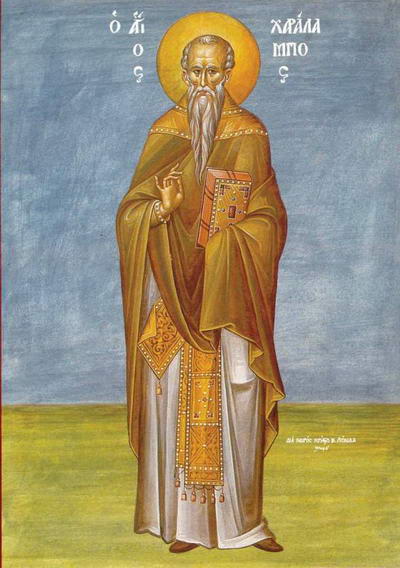 This great saint was bishop in Magnesia, and suffered for Christ at the age of 11When a violent persecution broke out under the Emperor Septimus Severus, the aged Charalampus did not hide from his persecutors, but freely and openly preached the Christian faith. He endured all tortures as though not in the body, and when they flayed the living flesh from him, the godly saint said to the Emperor"s soldiers: "Thank you, my brethren, for scraping off the old body and renewing my soul for new and eternal life." He performed many wonders and brought many to the Faith. Even the Emperor"s daughter, Gallina, repudiated the paganism of her father and became a Christian. Condemned to death and led to the place of execution, St Charalampus raised his arms to heaven and prayed for all men, that God would give them bodily health and salvation of soul, and that He would grant them the fruits of the earth in abundance: "Lord, Thou knowest that men are flesh and blood; forgive them their sins and pour out Thy blessing on all." After praying thus, the saintly elder gave his soul to God before the executioner had laid his sword to his neck. He suffered in 20Gallina took his body and buried it. This great saint was bishop in Magnesia, and suffered for Christ at the age of 11When a violent persecution broke out under the Emperor Septimus Severus, the aged Charalampus did not hide from his persecutors, but freely and openly preached the Christian faith. He endured all tortures as though not in the body, and when they flayed the living flesh from him, the godly saint said to the Emperor"s soldiers: "Thank you, my brethren, for scraping off the old body and renewing my soul for new and eternal life." He performed many wonders and brought many to the Faith. Even the Emperor"s daughter, Gallina, repudiated the paganism of her father and became a Christian. Condemned to death and led to the place of execution, St Charalampus raised his arms to heaven and prayed for all men, that God would give them bodily health and salvation of soul, and that He would grant them the fruits of the earth in abundance: "Lord, Thou knowest that men are flesh and blood; forgive them their sins and pour out Thy blessing on all." After praying thus, the saintly elder gave his soul to God before the executioner had laid his sword to his neck. He suffered in 20Gallina took his body and buried it.Our Holy Father Prochorus the Orach-Eater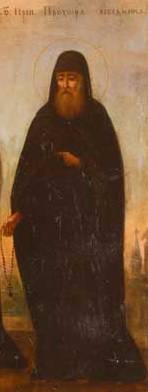 A wonder-worker of the Monastery of the Caves in Kiev, he w named the Orach-eater because the whole time he lived in t monastery, he never tasted bread but fed himself on orach prepared according to his own particular method as a sort of bread When he gave someone some of this bread with his blessing, it w as sweet as honey, but if anyone stole some, it was as bitter wormwood.
At one time, when there was a dearth of salt in Russia, Prochorus distributed ashes to the people for salt. The ashes that distributed with his blessing became salt; ashes, however, anyone took for himself remained ordinary ashes. Prince Svyatopol ordered that all the ashes from Prochorus' cell be brought to t court without his permission, let alone his blessing. When the ash were brought there, it was obvious to everyone that they were ash and not salt. Then Prochorus told all the people who came to him salt to go to the prince's court, and, when the prince threw the ash away, to take them and use them as salt. This they did, and the ash again became salt. The prince himself, learning of this, was filled with a deep respect and love for him and, when Prochorus died in 1107, placed him with his own hands in a grave near the great Russian Saints, Antony and Theodorius. A wonder-worker of the Monastery of the Caves in Kiev, he w named the Orach-eater because the whole time he lived in t monastery, he never tasted bread but fed himself on orach prepared according to his own particular method as a sort of bread When he gave someone some of this bread with his blessing, it w as sweet as honey, but if anyone stole some, it was as bitter wormwood.
At one time, when there was a dearth of salt in Russia, Prochorus distributed ashes to the people for salt. The ashes that distributed with his blessing became salt; ashes, however, anyone took for himself remained ordinary ashes. Prince Svyatopol ordered that all the ashes from Prochorus' cell be brought to t court without his permission, let alone his blessing. When the ash were brought there, it was obvious to everyone that they were ash and not salt. Then Prochorus told all the people who came to him salt to go to the prince's court, and, when the prince threw the ash away, to take them and use them as salt. This they did, and the ash again became salt. The prince himself, learning of this, was filled with a deep respect and love for him and, when Prochorus died in 1107, placed him with his own hands in a grave near the great Russian Saints, Antony and Theodorius.The Holy Virgin-Martyrs Hennatha, Valentina and Paula 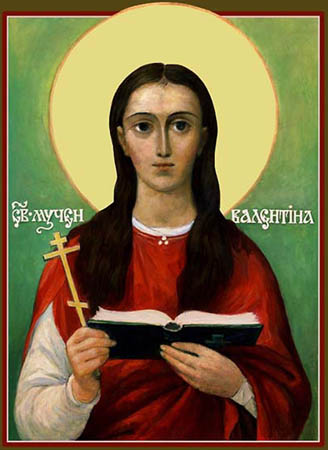 The Holy Virgin-Martyrs Hennatha, Valentina and Paula suffered in the year 308 under the emperor Maximian II Galerius (305-311). Saint Hennatha came from the city of Gaza (in the south of Palestine), Saint Valentina was a native of Palestinian Caesarea, and Saint Paula – from the surroundings of Caesarea.
Saint Hennatha was the first to be brought to trial before the governor Fermilian, bravely declaring herself a Christian. They beat her, and then they suspended her from a pillar and began to scourge her.
Saint Valentina, accused of not worshipping the gods, was led to a pagan temple for an offering of sacrifice, but she bravely hurled a stone at the sacrifice and turned her back on the burning of it with fire. They mercilessly beat her and sentenced her together with Saint Hennatha to beheading with a sword.
Last of all there was brought Saint Paula, whom they subjected to many torments. She endured them however by the help of God with great patience and courage. Before death Paula gave thanks to the Lord for strengthening her in the deed, and having bowed to the christians present, bent her neck beneathe the sword. The Holy Virgin-Martyrs Hennatha, Valentina and Paula suffered in the year 308 under the emperor Maximian II Galerius (305-311). Saint Hennatha came from the city of Gaza (in the south of Palestine), Saint Valentina was a native of Palestinian Caesarea, and Saint Paula – from the surroundings of Caesarea.
Saint Hennatha was the first to be brought to trial before the governor Fermilian, bravely declaring herself a Christian. They beat her, and then they suspended her from a pillar and began to scourge her.
Saint Valentina, accused of not worshipping the gods, was led to a pagan temple for an offering of sacrifice, but she bravely hurled a stone at the sacrifice and turned her back on the burning of it with fire. They mercilessly beat her and sentenced her together with Saint Hennatha to beheading with a sword.
Last of all there was brought Saint Paula, whom they subjected to many torments. She endured them however by the help of God with great patience and courage. Before death Paula gave thanks to the Lord for strengthening her in the deed, and having bowed to the christians present, bent her neck beneathe the sword.3 Female Martyrs in ThessalyThese three women witnessed the sufferings of St Charalampus and also began to glorify Christ. They were put to death with St Charalampus.
Saint Anastasius II, archbishop of Jerusalem (706) Synaxis of the Hierarchs of Novgorod, Buried in the Cathedral of the Holy Wisdom (Hagia Sophia) in NovgorodThe Synaxis of Novgorod Hierarchs is also celebrated on October 4 and on the third Sunday after Pentecost. On October 4, 1439 St John (September 7) appeared to the presiding hierarch St Euthymius (March 11) and ordered him to serve a special panikhida in memory of those buried at the Sophia cathedral (the Russian princes and Archbishops of Novgorod, and all Orthodox Christians) on the Feast of the Hieromartyr Hierotheus, first Bishop of Athens.
Then the incorrupt relics of St John (September 7) were uncovered. Afterwards, the Synaxis was established to mark the glorification of the Novgorod hierarchs. E. E. Golubinsky says that because these hierarchs remained unknown at the time of their glorification, he determined this date for their common celebration was established in the period between the time of the Moscow Council of 1549 and the time of the formation of the Holy Synod (E. E. Golubinsky, History of the Canonization of Saints in the Russian Church. Moscow, 1903, p. 157).
Included in the Synaxis of Novgorod hierarchs are: St Joachim of Korsun, first bishop of Novgorod (988-1030); St Luke the Jew, bishop (October 15, 1060); St Germanus, bishop (1078-1096); St Arcadius, bishop (September 18); St Gregory, archbishop (May 24, 1193); St Martyrius, archbishop (August 24, 1199); St Anthony, archbishop (October 8, 1231); St Basil the Lame, archbishop (July 3, 1352); St Simeon, archbishop (June 15, 1421); St Gennadius, archbishop (December 4); St Pimen, archbishop (1553-1571); Aphthonius, metropolitan (April 6, 1653).
The relics of these saints were buried or transferred to Novgorod’s Sophia Cathedral (except for St Germanus, St Gennadius and St Pimen) therefore, in some sources their names are not included in the Synaxis.
The October 4 celebration was established in connection with the memory of the holy Prince Vladimir Yaroslavich of Novgorod (+ 1052), and the February 10 Synaxis of the Novgorod hierarchs is celebrated in connection with the holy Princess Anna of Novgorod (+ 1056).
Besides those mentioned, hierarchs who have separate commemorations are: St Nikita the Hermit, bishop (January 31); St Niphon, bishop (April 8); St John, archbishop (September 7); St Theoctistus, archbishop (December 23); St Moses, archbishop (January 25); St Euthymius, archbishop (March 11); St Jonah, archbishop (November 5); St Serapion, archbishop (March 16).
Princess Anna of Novgorod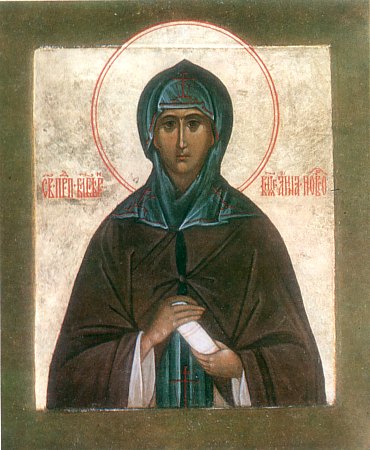 The NobleBorn Princess Anna of Novgorod, spouse of GreatPrince Yaroslav the Wise, gave a true Christian upbringing to her children, marked by a strong faith in God, love of work, integrity and learning. Her son Mstislav became afterwards GreatPrince of Kiev, and her daughter – queen of a West-European realm. The princess herself, having left the world, went into a monastery, where she finished her days in strict obedience and prayer in the year 1056. The NobleBorn Princess Anna of Novgorod, spouse of GreatPrince Yaroslav the Wise, gave a true Christian upbringing to her children, marked by a strong faith in God, love of work, integrity and learning. Her son Mstislav became afterwards GreatPrince of Kiev, and her daughter – queen of a West-European realm. The princess herself, having left the world, went into a monastery, where she finished her days in strict obedience and prayer in the year 1056.Icon of the Mother of God “Areovindus”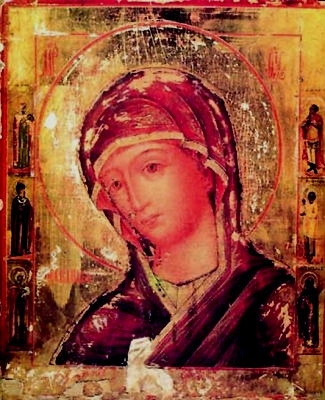 The origins of this unusual icon, in which the Most Holy Theotokos is depicted without Christ, are unknown. The bright red color of her outer garment inspired the name Areovindus, or “Fire Appearing” (“Fiery Vision”). The origins of this unusual icon, in which the Most Holy Theotokos is depicted without Christ, are unknown. The bright red color of her outer garment inspired the name Areovindus, or “Fire Appearing” (“Fiery Vision”). Venerable Longinus of Koryazhemsk, Vologda Saint Longinus of Koryazhemsk first pursued asceticism at the monastery of St Paul of Obnora, and then lived at the Sts Boris and Gleb Solvychegod monastery. From there he settled with his friend Simon near Vychegda, toward the mouth of the Koryazhema river.
Here, deep in the countryside, ten versts from Solvychegod, the ascetics built cells and a chapel. When brethren gathered around them, they built a church named for St Nicholas, and built a monastery in which the saint was igumen. Near the church there was a well, dug out by St Longinus himself.
After his death in 1540 the saint’s body was buried, in accord with his last wishes, near the entrance to the church. Sixteen years later, it was placed inside the church.
The memory of St Longinus is celebrated with a special service, and there is a brief Life, compiled at a later time. Saint Longinus of Koryazhemsk first pursued asceticism at the monastery of St Paul of Obnora, and then lived at the Sts Boris and Gleb Solvychegod monastery. From there he settled with his friend Simon near Vychegda, toward the mouth of the Koryazhema river.
Here, deep in the countryside, ten versts from Solvychegod, the ascetics built cells and a chapel. When brethren gathered around them, they built a church named for St Nicholas, and built a monastery in which the saint was igumen. Near the church there was a well, dug out by St Longinus himself.
After his death in 1540 the saint’s body was buried, in accord with his last wishes, near the entrance to the church. Sixteen years later, it was placed inside the church.
The memory of St Longinus is celebrated with a special service, and there is a brief Life, compiled at a later time. |